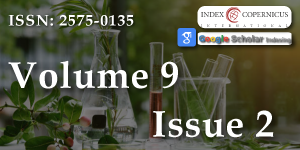Phenotypic Evaluation and Agronomic Adaptation of High-yielding Desi-type Chickpea (Cicer artinum L) Varieties at Wegdi and Legambo Districts of South Wollo, Ethiopia
Main Article Content
Abstract
Background: Chickpea (Cicer arietinum L.) (Chromosome number = 16) originated in southeastern Turkey and the boundary of Syria. A cultivation of low-yield homegrown chickpea cultivars is an unruly part of pulse crop production within Ethiopia. Consequently, this exploration is planned to examine the variability plus adaptability of Desi-type pulse cultivars aimed at harvest plus harvest constituent behaviors.
Approaches: A research was conducted by ten Desi-type plus cultivars, plus constructed a randomized complete block design was constructed by individual area through an organization of 3 by 10 treatments.
Outcomes: Acquired on erraticism evaluation, association among harvest-allied behaviors, constant of alteration, heritability, plus genomic improvement of behaviors existing at this point in the research. Investigation of deviation indicated extremely significant variation among varieties for the entire traits at every location. The mean seed yields were Aqaqi with a mean of 2727 and 2727 kg, Dalota with a mean of 4505 and 4883 kg, Dimtu with a mean of 4797 and 4899 kg, Fetenech with a mean of 2333 and 2333 kg, Mestawel with a mean of 4134 and 4367 kg, Minjar with a mean of 2927 and 2927 kg, Mitk with a mean of 2536 and 2536 kg, Natoli with a mean of 3690 and 4233 kg, Kutaye with a mean of 2883 and 2883 kg, and Teketai with a mean of 2647 and 2763 kg. Wide-ranging heritability ranged from 68.2% to 99.91% in this study.
Conclusion: From the tested varieties, Dalota, Dimtu, Mestawel, and Natoli were recommended materials to distribute to farmers in Legambo and Wegdi Districts, respectively.
Article Details
Copyright (c) 2025 Tefera H.

This work is licensed under a Creative Commons Attribution 4.0 International License.
Asnake F, Dagnachew B. Chickpea breeding and crop improvement in Ethiopia: past, present, and the future. Univ J Agric Res. 2020;8(2):33–40. Available from: https://www.hrpub.org/journals/article_info.php?aid=8860
Sfayhi D, Kharrat M. Physicochemical and cooking characteristics of Tunisian chickpea varieties. 2011. Available from: https://www.academia.edu/24867409/Physicochemical_and_Cooking_Characteristics_of_Tunisian_Chickpea_Varieties
Kumar A, Kumar N, Kumar S. Evaluation of chickpea (Cicer arietinum L.) genotypes through phenological traits under different sowing dates. Int J Pure App Biosci. 2019;7:221–225. Available from: https://www.ijpab.com/form/2019%20Volume%207,%20issue%206/IJPAB-2019-7-6-221-225.pdf
Shumi D, Alemayehu D, Afeta T. Adaptation study of improved chickpea (Cicer arietinum L.) varieties at mid and highland of Guji zone, Southern Ethiopia. Acad Res J Agric Sci Res. 2018;6(January):42–46. Available from: https://www.academicresearchjournals.org/ARJASR/PDF/2018/January/Shumi%20et%20al.pdf
McKenzie BA, Hill GD. Growth and yield of two chickpea (Cicer arietinum L.) varieties in Canterbury, New Zealand. N Z J Crop Hortic Sci. 2010;38(1):67–71. Available from: https://doi.org/10.1080/01140671.1995.9513925
Central Statistical Agency (CSA). Agricultural Sample Survey (2018), Report on area and production for major crops (private peasant holdings, main season). Addis Ababa, Ethiopia: CSA; 2019. Available from: https://www.sciepub.com/reference/339908
Gaur PM, Tripathi S, Gowda CLL, Ranga Rao GV, Sharma HC, Pande S, et al. Chickpea seed production manual. Patancheru, India: International Crops Research Institute for the Semi-Arid Tropics (ICRISAT); 2010;28p. Available from: https://tropicallegumeshub.com/wp-content/uploads/2020/07/ChickpeaManual_full.pdf
Anbazhagan K, Bhatnagar-Mathur P, Vadez V, Dumbala SR, Kishor PBK, Sharma KK. DREB1A overexpression in transgenic chickpea alters key traits influencing plant water budget across water regimes. Plant Cell Rep. 2015;34:199–210. Available from: https://doi.org/10.1007/s00299-014-1699-z
Walia MK, Mohammed YA, Franck WL, Chen C. Evaluation of early seedling development of chickpea and its relation to seed yield. Agrosyst Geosci Environ. 2020;1–9. Available from: https://doi.org/10.1002/agg2.20005
Tariku A. Evaluation and adaptability study of desi type chickpea (Cicer arietinum L.) varieties at Hirna districts of West Harerghe zone, Eastern Ethiopia. J Agric Res Adv. 2021;3(1):34–36. Available from: https://jara.org.in/uploads/archivepdf/6714JARA_Vol_03_March_2021_05.pdf
Watson A, Ghosh S, Williams MJ, Cuddy WS, Simmonds J, Rey MD, et al. Speed breeding is a powerful tool to accelerate crop research and breeding. Nat Plants. 2018;4:23–29. Available from: https://pubmed.ncbi.nlm.nih.gov/?term=Williams+MJ&cauthor_id=29292376
Muruiki R, Kimurto P, Vandez V, Gangarao R, Silim S, Siambi M. Effect of drought stress on yield performance of parental chickpea genotypes in semi-arid tropics. Am J Agric Biol Sci. 2018;12:159–168. Available from: http://dx.doi.org/10.17265/1934-7391/2018.03.006
Johnson PL, Sharma RN, Nanda HC. Genetic diversity and association analysis for yield traits of chickpea (Cicer arietinum L.) under rice-based cropping system. Bioscan. 2015;10(2):879–884. Available from: https://thebioscan.com/index.php/pub/article/view/1624?articlesBySimilarityPage=3
Kudapa H, Garg V, Chitikineni A, Varshney RK. The RNA-Seq-based high-resolution gene expression atlas of chickpea (Cicer arietinum L.) reveals dynamic spatiotemporal changes associated with growth and development. Plant Cell Environ. 2018;41:2209–2225. Available from: https://doi.org/10.1111/pce.13210
Chen Y, Ghanem ME, Siddique KHM. Characterising root trait variability in chickpea (Cicer arietinum L.) germplasm. J Exp Bot. 2017;68:1987–1999. Available from: https://doi.org/10.1093/jxb/erw368
Archak S, Tyagi RK, Harer PN, Mahase LB, Singh N, Dahiya OP, et al. Characterization of chickpea germplasm conserved in the Indian National Gene Bank and development of a core set using qualitative and quantitative trait data. Crop J. 2016;4:417–424. Available from: https://doi.org/10.1016/j.cj.2016.06.013
Maheri-sis N, Chamani M, Sadeghi A, Aghazadeh AM. Nutritional evaluation of kabuli and desi type chickpeas (Cicer arietinum L.) for ruminants using the in vitro gas production technique. Int J Curr Microbiol App Sci. 2018;7(16):2946–2951. Available from: https://www.researchgate.net/publication/239925904_Nutritional_evaluation_of_kabuli_and_desi_type_chickpeas_Cicer_arietinum_L_for_ruminants_using_in_vitro_gas_production_technique
Kiros W, Atsede T. Response of chickpea (Cicer arietinum L.) to Rhizobium inoculation and blended fertilizer rates in Laelay Maichew, central zone of Tigray, northern Ethiopia. Agric Sci. 2020;2:124–128. Available from: https://www.researchgate.net/publication/343586264_Response_of_Chickpea_Cicier_Arietinium_L_to_Rhizobium_Inoculation_and_Blended_fertilizer_Rates_in_Laelay_Maichew_Central_Zone_of_Tigray_Northern_Ethiopia
Kumawat S, Babbar A, Biswal M, Banjarey P. Morphological characterization of elite kabuli chickpea lines. Int J Curr Microbiol App Sci. 2020;9(9):1241–1250. Available from: https://doi.org/10.20546/ijcmas.2020.909.152
Daba K, Warkentin TD, Bueckert R, Todd CD, Tar’an B. Determination of photoperiod-sensitive phase in chickpea (Cicer arietinum L.). Front Plant Sci. 2016;7:478. Available from: https://doi.org/10.3389/fpls.2016.00478
Kalve S, Tadege M. A comprehensive technique for artificial hybridization in chickpea (Cicer arietinum). Plant Methods. 2017;13:52. Available from: https://doi.org/10.1186/s13007-017-0202-6
Gupta S, Nawaz K, Parween S, Roy R, Sahu K, Kumar Pole A, et al. Draft genome sequence of Cicer reticulatum L., the wild progenitor of chickpea, provides a resource for agronomic trait improvement. DNA Res. 2017;24:1–10. Available from: https://doi.org/10.1093/dnares/dsw042
Purushothaman R, Upadhyaya HD, Gaur PM, Gowda CLL, Krishnamurthy L. Kabuli and desi chickpeas differ in their requirement for reproductive duration. Field Crops Res. 2014;163:24–31. Available from: https://doi.org/10.1016/j.fcr.2014.04.006

